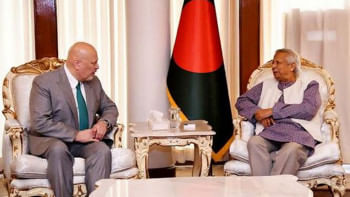Banks' costs mounting

Most of the banks' cost-to-income ratio, which is used to measure efficiency and productivity, accelerated in 2015 from a year earlier.
The higher ratio generally indicates lower efficiency, but a number of factors can affect the ratio, including a bank's business model, its size and the overall investment climate of a country, according to bankers.
The Daily Star compiled data of 15 major private banks to analyse the industry's costs in relation to its operating income.
Nine banks' costs escalated in 2015; four saw their costs decline, while two remained unchanged, data showed.
Of the banks, Dutch-Bangla's operating cost was the highest, 59 percent, followed by Uttara Bank at 57 percent and AB Bank at 53 percent.
On the other hand, Southeast Bank was the most efficient private sector bank with a cost-to-income ratio of 31 percent.
Bankers attributed the rise in cost-to-income ratio to the high nonperforming loans (NPL) and the declining interest income amid a sluggish demand for credit.
Some banks that still have high cost deposit are also earning less, bankers said.
"NPL, which is rising in the overall banking industry, has been squeezing banks' income," said MA Mannan, managing director of Islami Bank.
He explained saying that if a bank's NPL is 10 percent, it has to keep the same amount as provision from the profits.
Islami Bank's cost-to-income ratio increased about 10 percent in 2015 from a year earlier. Now, to generate Tk 100 of operating income its operating cost is Tk 48. The bank had to spend Tk 43 to earn the same amount in 2014.
The free-falling interest rate, which has come down close to single digit, has reduced the banks' incomes, said Abdul Halim Chowdhury, managing director of Pubali Bank.
"We are trying to leave out high cost deposits to reduce operating expenses and boost income," Chowdhury said.
Pubali's cost-to-income ratio remained unchanged at 47 percent, meaning that the bank has to spend Tk 47 to generate Tk 100 operating income.
"We have set a target to reduce the ratio to 40 percent this year," he said.
Dutch-Bangla Bank has stressed collecting low-cost deposits to reduce operating expenses, according to a top official of the bank.
"The number of low-cost deposit accounts has increased significantly. It is helping us to reduce our cost-to-income ratio," said Abul Kashem Mohammad Shirin, deputy managing director of Dutch-Bangla Bank.
Dutch-Bangla's cost-to-income ratio stood at 59 percent in 2015, down from 62 percent a year earlier.
Helal Ahmed Chowdhury, former managing director of Pubali Bank, suggested the banks improve their respective asset quality so that loans are not getting bad.
"Banks' monitoring and supervision have to be increased to reduce NPL and strengthen control on operating costs," said Chowdhury, who is now a director of Islami Bank.
Egypt posted the lowest average cost-to-income ratio at 27.7 percent in the world, as of December 31 last year, according to Standard & Poor's Global Market Intelligence analysis.
Chinese banks had an average ratio of 32.73 percent. Banks in Qatar, Kuwait and the UAE posted average ratios of 33.12 percent, 36.86 percent and 37.04 percent, respectively.
The average cost-to-income ratio of Indian private banks was 40.81 percent last year. Banks in Brazil were the least efficient in the analysis, with an average cost-to-income ratio of 98.17 percent.


 For all latest news, follow The Daily Star's Google News channel.
For all latest news, follow The Daily Star's Google News channel. 



Comments